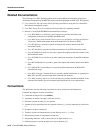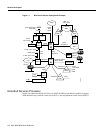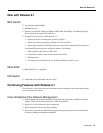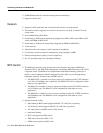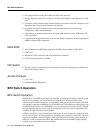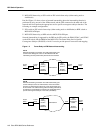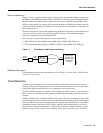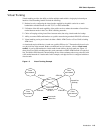
1-6 Cisco BPX 8600 Series Reference
BPX Switch Operation
• Easy integration into existing IPX switch and IGX switch networks.
• Internal diagnostics and self-test routines on all cards and backplane, status indication on each
card.
• Collection of many ATM and other network statistics and transfer of the data collected to Cisco
StrataView Plus over high-speed Ethernet LAN interface.
• Integration with the Cisco StrataView Plus Network Management System to provide
configuration, control, and maintenance.
• Conformation to recommendations from all current ATM standards bodies: ATM Forum, ITU,
ETSI, and ANSI.
• Compliant with all applicable safety, emissions, and interface regulations. Meets requirements of
NEBS for Central Office equipment.
MGX 8220
• Inverse Multiplexing ATM (IMA) support for the BPX switch with Rel. 3 MGX 8220
• CES T1/E1
• MGX 8220 T1/E1 frame relay and T1/E1 ATM service interfaces
• FUNI (Frame Based UNI over ATM)
IGX Switch
• The IGX switch is configurable as a tiered network routing hub supporting voice and data over
IGX switch interface shelves.
Access Products
• Cisco 3810
• FastPAD MM and MP products
BPX Switch Operation
BPX Switch Operation
With the BCC-4, the BPX switch employs a redundant 19.2 Gbps non-blocking crosspoint switch
matrix for cell switching. The switch matrix can establish up to 20 million point-to-point
connections per second between ports. A single BPX switch provides twelve card slots, with each
card capable of operating at 800 Mbps for ASI and BNI cards. The BXM cards support egress at up
to 1600 Mbps and ingress at up to 800 Mbps. Access to and from the crosspoint switch is through
multi-port network and user access cards. It is designed to easily meet current requirements with
scalability to higher capacity for future growth.
A BPX switch shelf is a self-contained chassis which may be rack-mounted in a standard 19-inch
rack or open enclosure. All control functions, switching matrix, backplane connections, and power
supplies are redundant, and non-disruptive diagnostics continuously monitor system operation to
detect any system or transmission failure. Hot-standby hardware and alternate routing capability
combine to provide maximum system availability.



